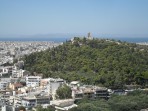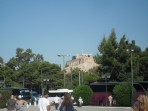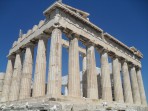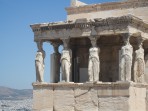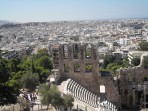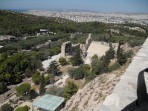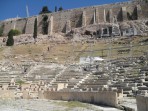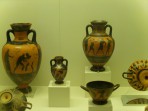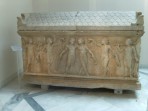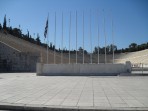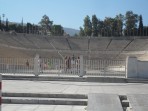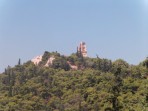Athens - capital city
Athens - Tourist Guide
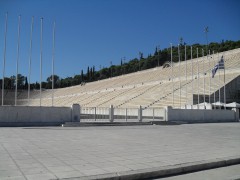
Tourism is a key sector of Greece's economic activity and the capital Athens is one of the country's most important tourist destinations. Moreover, Athens has seen a huge increase in the number of tourists in recent years. What is it about this historic city that attracts visitors from all over the world? And what can you expect from a visit?
Basic information about Athens
Athens or Athens (Athínai in Greek) is the capital of the Hellenic Republic, Greece. The city is located on the southern tip of mainland Greece, specifically on the Attica peninsula. It lies about 8 km from the Gulf of Sarona and from the Athenian port of Piraeus.
Athens has a population of about 664 000 inhabitants and the entire agglomeration (i.e. including surrounding cities such as Piraeus and others) has about 4.5 million inhabitants.
For most visitors, Athens is first and foremost a beautiful and historically valuable city with many unique monuments, a centre of classical Greek culture and architecture, or the "city of the gods". On the other hand, Athens today is also the economic, political and cultural centre of modern Greece, where almost half of the population lives. It is home to the Greek government, the presidency and other important state offices.
But Athens has retained much of its rich history, and tourists from all over the world head here to feel the energy of ancient times and to see for themselves the perfection and sophistication of the local monuments - the Acropolis, the Parthenon, the Temple of Erechtheum, the Propylaea, the Agora, the Odeum and other amazing sites.
The bulk of the city's income comes from tourism and Athens continues to increase its share of the overall Greek tourist market.
The subdivision of Athens
The most interesting tourist spots can be found in and around the centre of Athens. The dominant feature of the city and the most visited area is, of course, the archaeological zone on the Acropolis, with its many temples and other ancient monuments that extend further down the slopes of the Acropolis. Locals refer to this archaeological area as the "high city".
The "lower" part of the city is a classic tourist town with a variety of tourist services ranging from luxury hotels to renowned restaurants and pleasant taverns to small cafes and many souvenir shops. But even in the city centre itself there are many historically and architecturally beautiful places, including famous squares, historic buildings and green gardens and parks.
If you also want to visit Athens' quieter neighbourhoods, we recommend visiting Plaka, Monastiraki and Thissio, which are picturesque historic districts at the foot of the Acropolis, with restored 19th-century neoclassical houses, narrow pedestrian streets, shops and restaurants, and the remains of buildings from the Roman period.
By the sea, you can head to Athens' Glyfada district, which is also served by tram. It is a typical seaside resort with a nice beach, beach bars, small cafes and restaurants.
The appearance of the town was also significantly changed by the Olympic Games held here in 2004. In addition to the construction of a number of new sports venues and accompanying facilities, including the Santiago Calatrava-designed stadium, there have been significant improvements in transport infrastructure, notably a major expansion of public transport and the construction of a new international airport. Eleftherios Venizelos Athens International Airport is located to the east of the centre of Athens (between Koropi, Markopoulo and Loutsa).
The ancient port of Piraeus, today rated as one of the largest ports in Europe, is also part of the wider Athens area. Piraeus is the main commercial port for the Attica region.
History of Athens
The origins of Athens date back to the 3rd millennium BC, with the first major and important building appearing on the Acropolis around 1400, when a royal castle (Mycenaean period) was built. The period of Ancient Greece was crucial to the development of Athens, and today's most famous Athenian monuments date from this historical period.
In ancient times, Athens was also the city of the gods. The patron and protector of the city was the goddess Athena, to whom many of the city's historical monuments were dedicated. The god of fertility, wine and merriment, Dionysus, was also held in high esteem and one of the most important Athenian monuments dedicated to this god is the Dionysus Theatre.
An important figure of this period was the ruler Pericles, under whose reign (460-430 BC) Athenian democracy flourished and Athens became a centre of literature, philosophy and art. Monumental and unique buildings were built on and around the Acropolis - the Parthenon, the Temple of Erechtheum, the Propylaea, the smaller Temple of Athena Nike and others. There was also a huge statue of the goddess Pallas Athena on the Acropolis, of which, unfortunately, no part has survived to this day. The author of most of these buildings was the famous sculptor Feidias.
After the reign of Pericles, Athens fell into disputes with other Greek states and a period of uneasy alliances and many battles followed (Peloponnesian War, Corinthian War, Battle of Leuctes, Battle of Mantinea, etc.). From 146 BC, when Greece came under the domination of the Roman Empire, Athens experienced a long period of occupation by foreign powers. In 395, Greece, including Athens, became part of the Eastern Roman (or Byzantine) Empire, and in 1458, after a siege by the Ottomans, Athens fell to the Ottoman Empire.
The history of the city of Athens is both very long and very varied, and if you want to know even more about it, read the article History of the city of Athens.
Modern History of Athens
The modern history of Athens dates back to 1832, when the city once again became part of the independent modern Greek state.
But in 1833, Athens seemed to cease to exist altogether. During the struggle for independence, the city was completely evacuated in 1827 and only a few thousand people remained, surviving in small and poor houses on the northern slope below the Acropolis. The newly installed King Otto Hellenes (18-year-old son of Ludwig I of Bavaria) commissioned his German architects to build a new palace. The new Athens thus began to be built far out in the fields. The palace was relatively simple, but built on a very good site and included a large square connected to a beautiful garden (Síntagma Square).
As soon as Athens became the capital of Greece (1 January 1834), it grew in population by several percent each year until it soon reached about 50,000 inhabitants. Omônia Square was established at the western end of the two main streets, and then other wide streets radiated out from it. However, Omónia Square did not develop dynamically enough to create a balance to Síntagma Square. A railway line to the port of Piraeus was also built.
The large population growth was due both to the influx of refugees from Asia Minor during the 1920s and to the migration of the rural population during the Second World War and the Communist revolt (1946-49). The city grew rapidly, new urban districts were established and the surrounding villages became part of the city itself. The free green space suddenly disappeared. New development continued both northwards inland and southwards towards the sea and the port of Piraeus.
The port of Piraeus also underwent significant changes and the port became a clean, newly built city. With the growing international tourism, Ellinikon Airport, located south of the city, has also been enlarged and modernised.
Since about the 1960s, Athens has been a bustling, cosmopolitan city. Today, many Greeks live in Athens mainly during the winter and move to the most popular tourist destinations on the Greek islands in the summer for work.
The most famous Athenian monuments
- Acropolis – Together with the remains of Athens' oldest monuments, the Acropolis is a UNESCO World Heritage Site. The Acropolis has seen the gradual construction of huge and highly prized buildings, notably the Parthenon, the Erechtheum, the gateway of the Propylaea and the smaller temple of Athena Nike. Other important monuments also lie on the slopes of the Acropolis and in its vicinity, such as the Odeum of Herod Atticus, the Theatre of Dionysus, the Temple of Olympeion and the Arch of Hadrian.
- Parthenon Temple – the dominant structure on the Acropolis. A huge temple from the 5th century BC, dedicated to the city's patron goddess Athena. Throughout history, the temple has undergone some changes, also serving as a church or a mosque.
- Temple of Erechtheum (Erechteion) – smaller than the Parthenon, but in its time it represented the spiritual centre of Athens. The building also dates from the 5th century BC. Originally dedicated to the gods Athena and Poseidon, the temple was later dedicated to King Erechtheus.
- Propylaea – a huge marble staircase and a gate with five entrances served as the only entrance to the Acropolis, which could be closed in case of danger, making the Acropolis a fortress. The Propylaea were also built in the 5th century BC.
- Odeum of Herod Atticus – a younger structure that grew under the Acropolis in 161 AD. The Odeum has been largely preserved to the present day, and we can observe the unique semi-circular auditorium excavated into the rock and the surrounding three-storey façade of arches very well.
- Dionysus Theatre – The remains of the theatre lie on the southern slope of the Acropolis. It is an older building from the 6th century BC, but part of the theatre is still preserved today. The theatre was the site of festivals in honour of Dionysus, the god of fertility, wine and merriment.
- Temple of Zeus of Olympia (Olympeion) – a huge temple that stood on the plain below the Acropolis. Its size makes it one of the largest surviving temples in Greece, although only 15 tall Corinthian columns remain.
Athens is literally full of amazing historical monuments, often with interesting history or symbolism attached to them. For more information, see the separate article Athens and the most famous historical monuments.
Athenian officials and historians are also looking very closely at the negative impact of air pollution on the local monuments, and it is not rare to come across restorers and workers when visiting Athenian monuments. The famous Parthenon, for example, is now surrounded by scaffolding and cranes, as the goal of restorers is to carefully dismantle the structure, clean the parts and put them back in place.
Athens and other travel tips
In addition to these most famous historical monuments, which are the first places tourists go to, and which mainly include the remains of the oldest Athenian buildings, we can come across many other historically and culturally significant objects and natural attractions while walking around Athens.
Athens, for example, boasts several beautiful squares:
- Syntagma Square (Plateia Syntagmatos) – the main square of Athens. Its landmark is the old Royal Palace, which today serves as the seat of the Greek Parliament (since 1934). Syntagma Square forms part of the business district of Athens, so you will see a number of hotels, restaurants, banking institutions, corporate offices, etc. There is also a regular changing of the guard at the Tomb of the Unknown Soldier. In the middle of the square we can see a fountain from the middle of the 19th century.
- Monastiraki Square – a pebbly square with a long history. It is surrounded by many ancient buildings including the Roman Library of Hadrian, a church and a mosque. There's a neoclassical metro station and buildings from the modern era.
- Agia Irini Square – The square takes its name from the local church of Agia Irini, which was built in 1850 on the site of an older Christian church. The place was formerly known as the "flower market". Even today, there are stalls selling a variety of flowers, but it is more likely to be cafes and restaurants.
- Kolonaki Square – the word "kolonaki" means "little pillar" in Greek. The square has recently been renovated and has become a popular meeting place for the locals.
The Panathinaiko Stadium and Mount Likavittos, the highest peak in Athens, are also interesting tourist destinations:
- Panathinaiko Stadium – the stadium where the first modern Olympic Games were held in 1896. It is a huge stadium made of white marble, built in the shape of a horseshoe.
- Athens Academy – Walking through the city, you can also see the trio of noble academic buildings from the second half of the 19th century - the great neoclassical palace, the university and the library, which together form the Athens Academy.
- Mount Likavittos (or Lycabettus) – the highest peak of Athens. The hill is mostly forested, but there is also a restaurant and a large outdoor theatre. There is also the Chapel of St. George at the top of the hill. The green slopes of Mount Likavittós, mainly covered with pine trees, used to lie outside the city limits. Today, Mount Likavittós hovers in the middle of the city as a small green island, offering its visitors a breathtaking view of Athens and the sea in the distance. The hill is reached by cable car from the Athens district of Kolonaki.
Before visiting the capital, we recommend you study the map of Athens in detail and plan your trip at least a little in advance, because there are many beautiful and interesting places in Athens and you won't be able to see them all.
Transportation in Athens
When visiting Athens we can use a variety of public transport - trams, buses, metro and of course taxi service.
The local tram network is not very extensive and goes more to the outskirts of the city (e.g. the beaches), so buses and metro are the most used means of public transport. The bus network in Athens is quite dense, but on the other hand, it is very unorganised. Tourists are therefore advised to buy a bus map first and don't be afraid to ask. In addition to buses, the streets of Athens are also full of yellow taxis.
The Athens Metro was completed in 2000 and includes 3 lines that connect the city centre with outlying areas and the port of Piraeus. For exploring the city centre, you will mostly use the green and red lines, while the blue line will take you to the airport (green line: Piraeus - Kifissia, red line: Anthoupoli - Elliniko, blue line: Agia Marina - Doukissis Plakentias - airport).
Someone may be thinking about going to Athens by car. Of course, it is possible and some people are comfortable with this time flexibility, but in this case it is not recommended. Athens is a really big and busy city and there is no shortage of traffic violations, as drivers tend to get tired and irritable in the hot city streets. Traffic jams in the city centre are no exception. So if you're heading to Athens in your own (rental) car, the best way to get there is to park it in one of the parking lots on the outskirts of the city and continue on public transport.
Athens also has its own port and airport. Piraeus is the largest port in Greece, and is the main commercial port for the Attica region, as well as serving passenger shipping.
The new Eleftherios Venizelos International Airport in Athens, located 27 km east of the city centre (near the suburb of Spata), was opened in 2001 as part of the improvement of the city's transport infrastructure in preparation for the Olympic Games. Eleftherios Venizelos Airport has become one of Europe's major airports with a range of airport services, including duty-free shops, etc. There is also a small museum and temporary exhibition space on the top floor of the airport. Today there is talk of renovating and modernising it.
As one of the world's tourist capitals, Athens also has to contend with the issue of pollution. Pollution was the biggest problem in the 1980s and 1990s, when Athens was traditionally one of the most polluted cities in the world. The impetus to improve the situation came with the Olympic Games, which Athens wanted to host in 2004. And by then the city had really made great strides, including encouraging newer and greener vehicles and moving large factories out of the city.
Language and currency
The official language in Athens (as in all of Greece) is Greek. However, Athenians are used to the number of tourists from all over the world and so important signs, notices and menus, for example, are written in both Greek and English. Most Athenians are fluent in English and those working in tourist services (such as hotels, restaurants, etc.) often speak German and French as well.
Greece has been a member of the European Union since 1981 and adopted the Euro (EUR) as its currency in 2002.
Climate in Athens
A series of hills divide the town in the north-south direction. The Kifisós River flows through the western half of the town, which in summer is more like a stream. The eastern half is crossed by the Ilisós River, which is often even drier.
The climate in Athens is favourable. In winter, people rarely see sub-zero temperatures (the lowest temperatures are around 0ºC) and snow is rare. The lowest temperatures are in the northern suburbs of Athens, where residents often see a light dusting of snow. A unique sight came in January 2017, when Athens was hit by a heavy snowfall and snow was also lying on top of the Acropolis. However, winters in Athens tend to be generally mild and slightly rainy.
On the other hand, summers are hot (with highs around 37ºC) and dry. Temperatures traditionally climb highest in the city centre, where the warm air lingers between the hot buildings and squares. Unfortunately, some buses and trams still don't have air conditioning. More pleasant temperatures can be expected in the northern suburbs of the city and then in the coastal areas where a fresh north-easterly wind blows.
Spring and autumn are among the mild, transitional seasons with pleasant temperatures. And while spring sees rather minimal rainfall, autumn is the rainiest season, with the heaviest rainfall occurring in November.
The climate in the area thus allows locals to work outdoors almost all year round, and tourists to travel. The climate has also had, and continues to have, a significant influence on the style of the local architecture and the social and political life of Athens.
There are subtle differences between the different areas of Athens, but they are not significant. In general, the centre of the city tends to be the hottest and in summer it is the hottest. The northern suburbs of the city, where the more affluent districts such as Kifisia, Marousi, Nea Erythraia, Ekali, Dionysos or Thrakomakedones are mainly located, tend to be slightly cooler, mainly due to the higher altitude and also due to the greater density of woodland. The southern suburbs with the urban districts of Glyfada, Alimos, Faliro, Kallithea, Elliniko or Moschato are also cooler than the centre of Athens, in this case due to the proximity of the sea.
And a pearl at the end
In our country it is said "to bring wood to the forest", in Athens "to bring owls to Athens".

